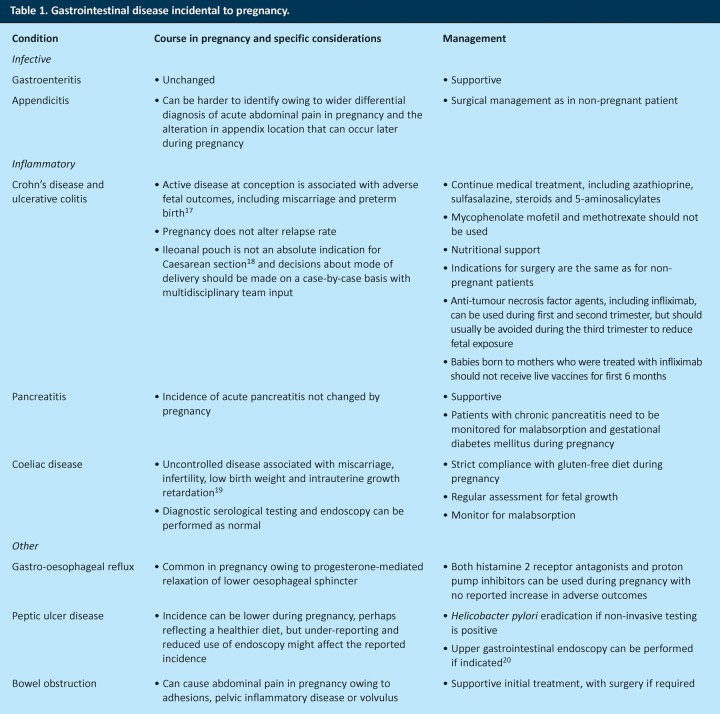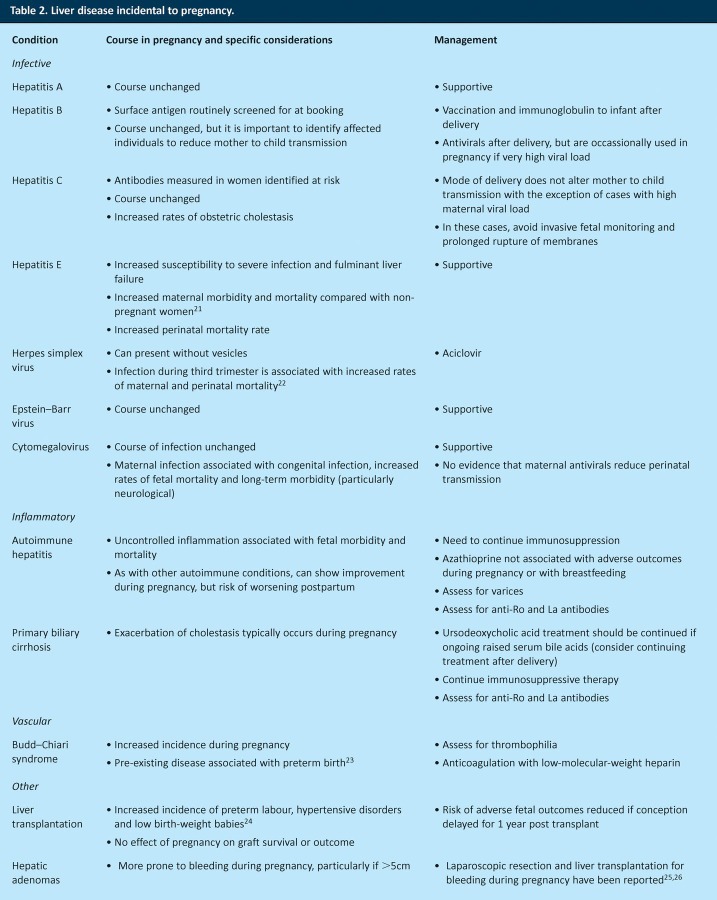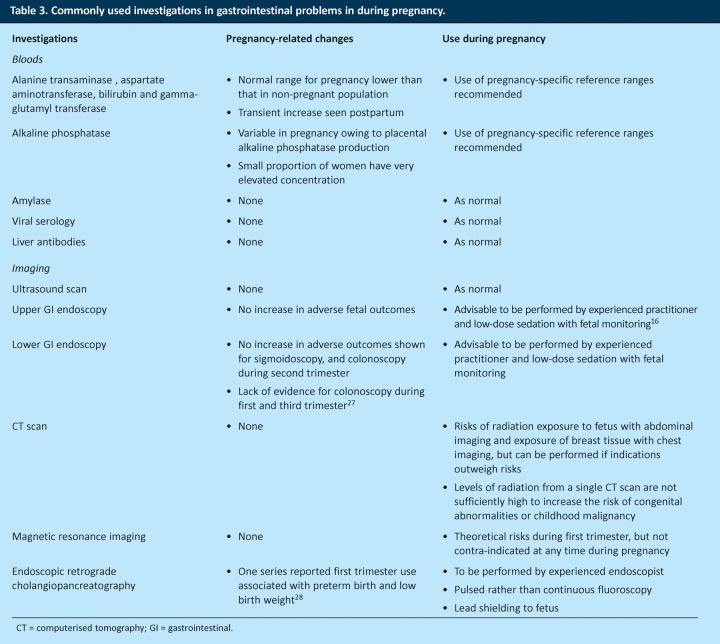Abstract
Gastrointestinal (GI) conditions are common in women of childbearing age. They often present before pregnancy but can arise de novo during pregnancy. The physiological changes that occur during pregnancy can influence the differential diagnosis of common GI presentations, affect the interpretation of diagnostic tests and restrict the use of diagnostic or therapeutic procedures. In this article, we summarise the clinical features, investigation and management of common GI and liver conditions that are incidental to pregnancy, and describe the specific features of pregnancy-related disorders that are less frequently encountered by general physicians. Newer developments in areas that are increasingly encountered in obstetric medical practice, including pregnancy after bariatric procedures, are also described.
KEY WORDS: Pregnancy, liver disease, HELLP syndrome, hypertensive disorders of pregnancy, obstetric cholestasis, hyperemesis gravidarum
Introduction
There are many gastrointestinal (GI) and liver conditions in the non-pregnant population that take a benign course and are unaffected when an individual becomes pregnant. Others can occur during pregnancy for the first time, but the pregnant state does not alter the time course of the condition or the management options. However, there are some disorders that, for reasons that are still unclear, can have a relatively benign course outside pregnancy but become life threatening during pregnancy, such as hepatitis E. There are several pregnancy-specific conditions that are described in this article that can be challenging not only for the general physician who only infrequently encounters this in day-to-day practice, but also for the obstetrician who rarely encounters the non-pregnancy-related medical conditions that can have similar presenting features to gestational disorders.
Gastrointestinal conditions
Diseases incidental to pregnancy
GI diseases that are incidental to pregnancy and the pregnancy-specific considerations relevant to these conditions are summarised in Table 1. The reader is referred to more detailed texts for more comprehensive descriptions of these disorders.1,2
Table 1.
Gastrointestinal disease incidental to pregnancy.
Pregnancy-specific conditions
Hyperemesis gravidarum. Although transient nausea and vomiting affect up to 50% of pregnant women, the development of severe nausea and vomiting sufficient to cause dehydration, biochemical derangement and nutritional deficiencies occurs in less than 1%. It is important to consider alternative diagnoses at the time of initial presentation because many other underlying pathologies can cause vomiting during pregnancy, including intracranial space-occupying lesions, peptic ulcer disease and hyperthyroidism. In each triennium reported in the Confidential Enquiry into maternal deaths, there are deaths associated with hyperemesis gravidarum.3
Admission to hospital might be required for rehydration and anti-emetic administration. Drugs commonly used include cyclizine, metoclopramide, promethazine and prochlorperazine. There are good safety data for these drugs in pregnancy. If these drugs are not successful alone or in combination, ondansetron and parenteral hydrocortisone, followed by prednisolone, are second-line treatment options. Thiamine supplementation should also be given to prevent Wernicke’s encephalopathy. Fetal scanning is required on presentation because the incidence of hyperemesis is increased in multiple or molar pregnancies. Care should be taken to identify and correct hyponatraemia and hypokalaemia. Blood tests can also reveal biochemical hyperthyroidism, but this is usually a transient phenomenon and resolves with treatment of the hyperemesis.
Special situations
Bariatric surgery
As the mean body mass index of the pregnant population is increasing, so too is the number of pregnant patients who have previously had some form of bariatric procedure, including gastric banding or Roux en Y surgery. These patients are usually advised to avoid conception during the year following the procedure owing to theoretical concerns about nutrition and conception during a period of significant weight loss; however, studies have not shown that adverse fetal outcomes are reduced if conception is delayed in this way.4
There is a risk of malabsorption and nutritional deficiencies, including fat soluble vitamins, particularly if biliopancreatic diversion has been performed. Therefore, this requires monitoring and appropriate replacement during pregnancy.
The differential diagnosis of acute abdominal pain in pregnancy is wider if the patient has had a previous bariatric procedure, because complications can occur, such as band slippage, small bowel obstruction owing to herniation and intussusception.
Nutrition
The precise nutritional requirements during pregnancy are unknown, but malabsorptive conditions are associated with intrauterine growth restriction and therefore it is advisable to perform additional fetal monitoring in any patient with a history of malabsorption. Consideration should be given to assessment of fat-soluble vitamins, calcium and vitamin D and iron, particularly in patients receiving parenteral or enteral feeding.
Liver disease
Mildly deranged liver function tests are common during pregnancy, with one study identifying abnormalities in 3% of all deliveries.5 However, fulminant liver failure is rare, with a major tertiary centre identifying only 54 cases of pregnancy-related liver failure over an 11-year period.6 Many features of common liver conditions overlap with pregnancy-specific liver disorders; therefore, a careful history and physical examination are key tools in identifying the underlying disorder. It is important to exclude non-gestational causes of liver dysfunction, including drug-induced hepatic impairment and biliary disease, before assuming that liver dysfunction is secondary to pregnancy.
Disorders incidental to pregnancy
Liver disease incidental to pregnancy and the pregnancy-specific considerations are summarised in Table 2. The reader is referred to more detailed texts for more comprehensive descriptions of these disorders.1,7
Table 2.
Liver disease incidental to pregnancy.
Pregnancy-specific conditions
Hypertensive disease of pregnancy. Liver function tests are often deranged in the setting of disorders that fall within the spectrum of disease that includes pre-eclampsia, eclampsia and the haemolysis, elevated liver enzymes and low platelets (HELLP) syndrome; significant liver impairment is most commonly associated with the latter. Women can be asymptomatic at the time of onset of hepatic impairment, but headache, right upper quadrant pain and visual disturbance more commonly occur. There can be hypertension and proteinuria on examination, but in HELLP syndrome the haematological and biochemical features can precede the development of these abnormalities, making the diagnosis more challenging.8 The condition can be unheralded, which adds to the difficulty in identifying affected individuals. There is no consensus on the level at which raised liver transaminases make HELLP syndrome more likely.
There is significant morbidity and mortality associated with HELLP syndrome, including formation of subcapsular hepatic haematoma, capsular rupture and non-hepatic complications of severe pre-eclampsia, such as intracerebral haemorrhage. These cause a few maternal deaths in the UK every year, as described in the Confidential Enquiry into maternal deaths.3 The only curative treatment is delivery, but given the potential severity of the condition, resuscitation and stabilisation of the patient are required before this. Blood products, including platelets, can be required, but their use depends on the clinical condition of the affected woman.
The recurrence rate for HELLP syndrome is low, although the risk of subsequent early-onset pre-eclampsia in these individuals is high.8
Acute fatty liver of pregnancy. The symptoms and signs of acute fatty liver of pregnancy (AFLP) can be non-specific, and there are often prodromal symptoms over a few days before presentation, including vomiting, reduced appetite, abdominal pain, polyuria and polydipsia. Hyperlactataemia and hypoglycaemia can also occur. A study performed in Wales assessed the clinical features of patients with a probable diagnosis of AFLP and identified several criteria (referred to as the ‘Swansea criteria’, listed in Box 1) that can aid diagnosis when other causes of these abnormalities have been excluded.5
Box 1. Diagnostic criteria for acute fatty liver of pregnancy (Swansea criteria).5.
In contrast to the macrovesicular steatosis seen in non-alcoholic fatty liver disease and the more chronic course that is seen in this condition, the main abnormality in AFLP is microvesicular steatosis, as is seen in Reye’s syndrome. Both are associated with acute, severe disease that can be life threatening.
The treatment for AFLP is delivery, but the hepatic insult is so severe in some cases that liver transplantation is required. N-acetylcysteine is used in many centres for acute liver failure related to AFLP, but there are no studies to show that this improves outcomes.
Several studies have identified an association between AFLP and fetal homozygosity for disorders of β-fatty acid oxidation, such as long chain 3 hydroxyl-acyl-coenzyme A dehydrogenase (LCHAD) deficiency. This is thought to be explained by inadequate clearance of hepatotoxic metabolites by the liver of the mother who will be an obligate heterozygote for the same mutation as the fetus.9
There are limited data relating to the recurrence of AFLP in subsequent pregnancies. If a woman has a confirmed β-fatty acid oxidation disorder, she is likely to have a 25% chance of recurrence. For other cases, it is difficult to advise about recurrence. However, many women do not go on to have a further pregnancy owing to anxiety related to the severity of the AFLP during the previous affected pregnancy.
Obstetric cholestasis. Obstetric cholestasis (OC) is also called intrahepatic cholestasis of pregnancy, and is the most common liver condition specific to pregnancy. The main feature of this condition is pruritus, most commonly affecting the palms and soles, without associated skin changes, in combination with an elevated serum bile acid concentration. Jaundice can occur but is uncommon (affecting <5%). Pale stools and dark urine might also be described. Approximately 15% of affected women have a history of similar symptoms when taking the combined oral contraceptive pill, and there is often a family history of gallstones or OC in female relatives. Examination is likely to be normal.
It is important to consider other diagnoses; therefore, it is advised to perform liver autoantibodies, hepatitis serology (OC occurs more commonly in women that are seropositive for hepatitis C virus) and an ultrasound scan of liver in all women presenting with these symptoms for the first time during pregnancy. Measurement of serum bile acids helps to confirm the diagnosis, but an elevated result is not specific for this condition. Transaminases can be normal, but require frequent monitoring because these often become deranged as pregnancy progresses.
OC is associated with an increased risk of adverse pregnancy outcomes, including meconium-stained amniotic fluid, spontaneous preterm labour, fetal distress and fetal death. Some studies have suggested that these are more likely with higher bile acid levels.10 The latter is postulated to be the result of cardiac arrhythmias, because bile acids have been shown to be arrhythmogenic in rat cardiac myocytes.11 Given that fetal deaths tend to occur during later gestational weeks, the development of OC would prompt induction of labour from 37 weeks’ gestation onwards in many centres, but this is not universal practice.12 Therefore, initial management is usually pharmacological with ursodeoxycholic acid (UDCA), a hydrophilic bile acid that stimulates bile acid release from the hepatocyte. This can reduce maternal symptoms and be associated with an improvement in maternal biochemistry.13 Several studies have indicated that UDCA treatment can improve pregnancy outcome, but this needs to be evaluated by an adequately powered clinical trial.14,15
Investigations
Most relevant investigations for GI and liver conditions can be performed as normal during pregnancy. Endoscopy is not contra-indicated, although it should only be performed during pregnancy if a woman is sufficiently unwell that it is not appropriate to delay the investigation until the postnatal period and the results would potentially alter management during pregnancy. It is advised that endoscopy should be performed by the most senior operator available, with fetal monitoring and cautious use of sedative agents.16
The effect of pregnancy on other investigations is summarised in Table 3.
Table 3.
Commonly used investigations in gastrointestinal problems in during pregnancy.
Conclusions
A careful history and examination are of the utmost importance when assessing a pregnant woman with a GI or liver abnormality. Most drugs can be used safely and appropriately during pregnancy and careful consideration should be given before any medication is stopped in preparation for possible conception. A multidisciplinary team approach is key for the successful management of pregnancies complicated by conditions such as those described here, to optimise the maternal and fetal outcome.
References
- 1.Powrie RO, Greene MF, Camann W, editors. de Swiet’s Medical Disorders in Obstetric Practice. 5th edn. Chichester: Wiley-Blackwell; 2010. [Google Scholar]
- 2.Van der Woude CJ, Kolacek S, Dotan I, et al. European evidenced-based consensus on reproduction in inflammatory bowel disease. J Crohns Colitis. 2010;4:493–510. doi: 10.1016/j.crohns.2010.07.004. [DOI] [PubMed] [Google Scholar]
- 3.Cantwell R, Clutton-Brock T, Cooper G, et al. Saving mothers’ lives. Reviewing maternal deaths to make motherhood safer: 2006–2008. The eighth report on confidential enquiries into maternal deaths in the United Kingdom. BJOG. 2011;118(suppl 1):1–203. doi: 10.1111/j.1471-0528.2010.02847.x. [DOI] [PubMed] [Google Scholar]
- 4.Dao T, Kuhn J, Ehmer D, et al. Pregnancy outcomes after gastric-bypass surgery. Am J Surg. 2006;192:762–6. doi: 10.1016/j.amjsurg.2006.08.041. [DOI] [PubMed] [Google Scholar]
- 5.Ch’ng CL, Morgan M, Hainsworth I, Kingham JG. Prospective study of liver dysfunction in pregnancy in Southwest Wales. Gut. 2002;51:876–80. doi: 10.1136/gut.51.6.876. [DOI] [PMC free article] [PubMed] [Google Scholar]
- 6.Westbrook RH, Yeoman AD, Joshi D, et al. Outcomes of severe pregnancy-related liver disease: refining the role of transplantation. Am J Transplant. 2010;10:2520–6. doi: 10.1111/j.1600-6143.2010.03301.x. [DOI] [PubMed] [Google Scholar]
- 7.Frise CJ, Williamson C. Liver disease in pregnancy. Medicine. 2011;39:576–9. doi: 10.1016/j.mpmed.2011.07.012. [DOI] [Google Scholar]
- 8.Sibai BM. Diagnosis, controversies, and management of the syndrome of hemolysis, elevated liver enzymes, and low platelet count. Obstet Gynecol. 2004;103:981–91. doi: 10.1097/01.AOG.0000126245.35811.2a. [DOI] [PubMed] [Google Scholar]
- 9.Treem W, Rinaldo P, Hale DE, et al. Acute fatty liver of pregnancy and long-chain 3-hydroxyacyl-coenzyme A dehydrogenase deficiency. Hepatology. 1994;19:339–45. [PubMed] [Google Scholar]
- 10.Geenes V, Williamson C. Intrahepatic cholestasis of pregnancy. World J Gastroenterol. 2009;15:2049–66. doi: 10.3748/wjg.15.2049. [DOI] [PMC free article] [PubMed] [Google Scholar]
- 11.Williamson C, Gorelik J, Eaton BM, et al. The bile acid taurocholate impairs rat cardiomyocyte function: a proposed mechanism for intra-uterine fetal death in obstetric cholestasis. Clin Sci. 2001;100:363–9. doi: 10.1042/CS20000164. [DOI] [PubMed] [Google Scholar]
- 12.Saleh M, Abdo K. Consensus on the management of obstetric cholestasis: National UK survey. BJOG. 2007;114:99–103. doi: 10.1111/j.1471-0528.2006.01102.x. [DOI] [PubMed] [Google Scholar]
- 13.Glantz A, Marschall HU, Lammert F, Mattsson LA. Intrahepatic cholestasis of pregnancy: a randomized controlled trial comparing dexamethasone and ursodeoxycholic acid. Hepatology. 2005;42:1399–1405. doi: 10.1002/hep.20952. [DOI] [PubMed] [Google Scholar]
- 14.Chappell LC, Gurung V, Seed PT, et al. Ursodeoxycholic acid versus placebo, and early term delivery versus expectant management, in women with intrahepatic cholestasis of pregnancy: semifactorial randomised clinical trial. BMJ. 2012;344:e3799. doi: 10.1136/bmj.e3799. [DOI] [PMC free article] [PubMed] [Google Scholar]
- 15.Bacq Y, Sentilhes L, Reyes HB, et al. Efficacy of ursodeoxycholic acid in treating intrahepatic cholestasis of pregnancy: a meta-analysis. Gastroenterology. 2012;143:1492–501. doi: 10.1053/j.gastro.2012.08.004. [DOI] [PubMed] [Google Scholar]
- 16.Qureshi WA, Rajan E, Adler DG, et al. ASGE Guideline: guidelines for endoscopy in pregnant and lactating women. Gastrointest Endosc. 2005;61:357–62. doi: 10.1016/S0016-5107(04)02780-4. [DOI] [PubMed] [Google Scholar]
- 17.Nørgård B, Hundborg HH, Jacobsen BA, et al. Disease activity in pregnant women with Crohn’s disease and birth outcomes: a regional Danish cohort study. Am J Gastroenterol. 2007;102:1947–54. doi: 10.1111/j.1572-0241.2007.01355.x. [DOI] [PubMed] [Google Scholar]
- 18.Cornish JA, Tan E, Teare J, et al. The effect of restorative proctocolectomy on sexual function, urinary function, fertility, pregnancy and delivery: a systematic review. Dis Colon Rectum. 2007;50:1128–38. doi: 10.1007/s10350-007-0240-7. [DOI] [PubMed] [Google Scholar]
- 19.Khashan AS, Henriksen TB, Mortensen PB, et al. The impact of maternal celiac disease on birthweight and preterm birth: a Danish population-based cohort study. Hum Reprod. 2010;25:528–34. doi: 10.1093/humrep/dep409. [DOI] [PubMed] [Google Scholar]
- 20.Cappell MS, Colon VJ, Sidhom OA. A study of eight medical centers of the safety and clinical efficacy of esophagogastroduodenoscopy in 83 pregnant females with follow-up of fetal outcome with comparison control groups. Am J Gastroenterol. 1996;91:348–54. [PubMed] [Google Scholar]
- 21.Kumar A, Beniwal M, Kar P, et al. Hepatitis E in pregnancy. Int J Gynecol Obstet. 2004;85:240–4. doi: 10.1016/j.ijgo.2003.11.018. [DOI] [PubMed] [Google Scholar]
- 22.Corey L, Wald A. Maternal and neonatal herpes simplex virus infections. N Engl J Med. 2009;361:1376–85. doi: 10.1056/NEJMra0807633. [DOI] [PMC free article] [PubMed] [Google Scholar]
- 23.Rautou PE, Angermayr B, Garcia-Pagan JC, et al. Pregnancy in women with known and treated Budd–Chiari syndrome: Maternal and fetal outcomes. J Hepatol. 2009;51:47–54. doi: 10.1016/j.jhep.2009.02.028. [DOI] [PubMed] [Google Scholar]
- 24.Christopher V, Al-Chalabi T, Richardson PD, et al. Pregnancy outcome after liver transplantation: a single-center experience of 71 pregnancies in 45 recipients. Liver Transpl. 2006;12:1138–43. doi: 10.1002/lt.20810. [DOI] [PubMed] [Google Scholar]
- 25.Wilson CH, Manas DM, French JJ. Laparoscopic liver resection for hepatic adenoma in pregnancy. J Clin Gastroenterol. 2010;45:828–33. doi: 10.1097/MCG.0b013e3181f97747. [DOI] [PubMed] [Google Scholar]
- 26.Santambrogio R, Marconi A, Ceretti A, et al. Liver transplantation for spontaneous intrapartum rupture. Obstet Gynecol. 2009;113:508–10. doi: 10.1097/AOG.0b013e318187ff42. [DOI] [PubMed] [Google Scholar]
- 27.Cappell MS. Risks versus benefits of gastrointestinal endoscopy during pregnancy. Nat Rev Gastroenterol Hepatol. 2011;8:610–34. doi: 10.1038/nrgastro.2011.162. [DOI] [PubMed] [Google Scholar]
- 28.Tang SJ, Mayo MJ, Rodriguez-Frias E, et al. Safety and utility of ERCP during pregnancy. Gastrointest Endosc. 2009;69:453–61. doi: 10.1016/j.gie.2008.05.024. [DOI] [PubMed] [Google Scholar]






